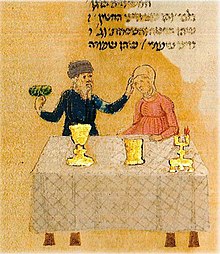Rothschild Miscellanea

The Rothschild Miscellanea is an illuminated Hebrew composite manuscript from the Italian Renaissance that is now in the Israel Museum in Jerusalem under the signature MS. 180/51 is kept. It was inscribed on the World Document Heritage List in 2013 . It was created in the last quarter of the 15th century and consists of more than 70 religious and secular writings, including Psalms, Proverbs, the Book of Job as well as a Passover - Haggadah. The secular books include philosophical, moralistic, and scientific treatises. On a total of 473 sheets of parchment, more than 200 miniatures illustrate different texts down to the last detail. The diverse collection contains an abundance of depictions of the manners and customs of daily life in a Jewish household during the Renaissance.
Emergence
The manuscript was commissioned in 1479 by Moses ben Jekutiel Ha-Kohen, a Jew from Cremona in Lombardy. The small-format manuscript (210 × 156 mm) was probably created in a workshop in the vicinity of Ferrara . This is suspected by the Israeli art historian Mordechai Narkiss , who pointed out that the miniatures are stylistically related to the Borso d' Este Bible . He assumes that the illustration was done by several artists or a workshop group. Ulrike Bauer-Eberhardt ascribes the miniatures to Leonardo Bellini , one of the most important representatives of Venetian book illumination of the Renaissance and non-Jew.
Ownership history
Between 1832 and 1855 the manuscript was in the Solomon de Parente collection in Trieste . There it was acquired by James de Rothschild . In Paris, the manuscript remained in the Rothschild library under the call number Ms. 24 until it disappeared during the German occupation and reappeared in New York after the Second World War . In 1950 it was offered for sale to the librarian of the Jewish Theological Seminary there , Alexander Marx . He recognized the manuscript and notified the Rothschild family. The Codex initially remained on loan in New York and was incorporated into the Rothschild Collection in London in 1952. In 1957 the manuscript was donated to the Israel Museum in Jerusalem. It kept its name Rothschild Miscellanea .
literature
- Rothschild miscellany, Jerusalem, Israel Museum, Ms. 180/51 (= Vol. 3). In: (Eds.) Bezalel Narkiss and Gabrielle Sed-Rajna in collaboration with Jonathan Benjamin et al .: Iconographical index of Hebrew illuminated manuscripts , Jerusalem, Paris 1983 ( LoC catalog entry )
- Ulrike Bauer-Eberhardt: The Rothschild Miscellanea in Jerusalem. Major work of Leonardo Bellini . In: Pantheon. Vol. 42, Issue 3, 1984, pp. 229-237.
- Facsimile (Hebrew). In: The Rothschild Miscellany. Vol. 1. Jerusalem 1989, ISBN 0-948223-03-0 .
- Michael and Linda Falter (Eds.): A scholary commentary . In: The Rothschild Miscellany. Vol. 2. Jerusalem 1989. ( HeBIS catalog entry )
- (Ed.) Jeremy Schonfild: The Rothschild Haggadah: a Passover compendium from the Rothschild Miscellany ; a facsimile edition of 550 copies, with companion volume, London 2000. ( LoC catalog entry )


